
Atlas F1 News Editor
The first round of the 2002 Formula One World Championship season seemed to continue exactly where the last round of the 2001 season had left off, but while the winning car was something old, a few welcome and surprising results offered something new. The Australian Grand Prix was by no means a boring race, and Pablo Elizalde reviews, as always, this action-packed weekend
It is true that the Australian race was only the first event of a very long Championship in which anything can happen and probably will; however, the relative ease with which Schumacher and Ferrari got the upper hand on their rivals can be seen as a sign of the continuation of a superiority that turned last season into a triumphal procession for the Champion and his team.
Despite Schumacher initially claiming publicly that his goal for the opening race of the season was to score three or four points as a result of Ferrari's decision to use the 'old' chassis, it was not hard to envisage that the Italian team were confident of their chances of success. The F2001 was the class of the field at the end of last year, and with the lack of testing time for their rivals to develop their new machines, Ferrari arrived in Melbourne with a car that was still one step ahead of the competition in terms of development and reliability.
"I did not want to say too much before," admitted Ferrari's technical director Ross Brawn after the race. "But the car was so good in Suzuka and we have developed it a lot since then." In Australia, the calculated risk paid off and the World Champions were always one step ahead of their closest rivals Williams and McLaren. Schumacher, as usual, was lucky, or good, enough to avoid the mayhem at the start, and once he got rid of all his rivals, he took off and ran a lonely race in front.
The first corner chaos, which took eight drivers out of the race, made it harder to judge who was where in Australia, and qualifying was not useful either once it started raining, halfway into the session. But if something could be read from it, and from the previous practice sessions, is that Schumacher's main rival last weekend was probably his own teammate, and that was not good news for McLaren or Williams.
Of course, despite the accident, the other two men who are supposed to give Schumacher a run for his money this season - Juan Pablo Montoya and David Coulthard - were still in the race, and the Ferrari driver did not have many problems outperforming them, and especially their Michelin-shod cars. Despite a better knowledge a what is clearly a fast car, Ferrari benefited from Bridgestone's superior performance compared to their French rivals. "I thought we were going to be competitive, but as soon as he got (the right tyre) temperatures there was nothing to do," said a frustrated Montoya, who saw Schumacher disappear into the distance.
But it was not all bad news for those who did not win the race, and though Coulthard endured a nightmare Grand Prix that saw him running more off than on the track, McLaren could console themselves knowing that Kimi Raikkonen will soon be competitive enough to be fighting for the lead. The young Finn did not have an easy race, but recovered well to earn a deserved third place after setting the quickest lap.
Behind the top three, it was all smiles for those who made it to the end of the race. Jaguar welcomed a fortunate fourth place after a torrid qualifying - one which they must surely hope is not a true measure of their abilities this year. Nineteenth and 20th positions on the grid is definitely not the place where owners Ford want them to be. Not behind the similarly Cosworth-powered Arrows, and surely not behind rookies Toyota.
The Japanese squad impressed in their first ever Grand Prix, no matter what was expected from them, and Mika Salo's sixth place was a nice reward for a team in which only five or six staff members had previously been involved in Formula One.
However, the loudest cheers on Sunday were for Australian Mark Webber and his Minardi team, who returned to the points after a gutsy performance by the rookie. "We already achieved our entire job for this year in one race," said team boss Paul Stoddart while celebrating their best result since 1994.
Qualifying
The dark clouds that covered the Melbourne track at the start of the session, and the heavy rain that hit the circuit during the second half, didn't allow the end result to be a true indication of who was hot and who was not. At the end, it was Rubens Barrichello and his 'old' Ferrari who got the best of the conditions in the short period of time that the track was dry.
Having dominated every practice session both on Friday and Saturday by more than one second over their closest rival, and with the low track temperatures helping their Bridgestone tyres, it came as no surprise to see an all Ferrari front row, although this time it was not Michael Schumacher on pole.
Barrichello, who had scored his previous three pole positions in similar weather conditions, was one of the few lucky men who could complete two competitive runs, and it paid off, as Barrichello finished five thousandths of a second ahead of teammate Schumacher. It was the fourth time since Barrichello joined Ferrari in 2000 that he was able to outqualify the German, and the first wet qualifying session in Australia in seven years.
David Coulthard had not been very lucky in the first minutes either, touching the wall with his McLaren after an incident with Jacques Villeneuve's BAR. "I came out of the second last corner on my first flying lap and Jacques Villeneuve was on the left," explained the Scot. "I went to go out on the outside of him, but unfortunately he moved over and squeezed me against the wall, which I fortunately only touched a little."
Before the red flags came out, Barrichello was the first driver to set a relatively competitive time, before Coulthard, and then Ralf Schumacher with his Williams moved to first place with a 1:26.279 lap after the action resumed.
After making a mistake in his first run, Michael Schumacher completed what would be his only real flying lap, with a time of 1:25.843 - already one second quicker than his pole position time the previous year, despite a small error during his lap. "The lap that counted for my grid position could have been better, as I went off onto the grass," he later said. "I discovered it has less grip than I wanted."
Juan Pablo Montoya, who was beginning his second attempt, could not even complete his lap as the track was flooded very quickly, forcing the Williams driver to settle for a disappointing sixth place on the grid. "I had only one run and I think I lost about six or eight tenths because Fisichella held me up," the Colombian said. "That was a bit disappointing because there was a lot more to come in the car."
The teams, and the spectators, hoped for the rain to stop, but it only got worse, and everybody had to be content with what they achieved. Barrichello, for one, was a happy man: "I love the rain, fourth time with bad weather, which for me is good weather. This is a very good beginning to the season. I had a strong winter testing, I feel very relaxed and I have changed my approach to my job."
Teammate Schumacher had to settle with second, while his brother Ralf was third, ahead of Coulthard and Kimi Raikkonen in the second McLaren. Further back there were some surprising results, but whether they were caused by the rain or by pure performance will not be clear until the season progresses.
Jarno Trulli with the new Renault was the best of the rest in seventh, ahead of the man with whom he has switched places, Giancarlo Fisichella in the Jordan. Teammate Sato was unable to complete a lap in the dry, and so didn't set a competitive time. Fortunately for the young rookie, the stewards allowed him to race on Sunday.
Toyota's showing, added to Arrows' performance and to the brilliant job by Webber in the Minardi, made for an embarrassing day for the Jaguar team, who saw their drivers finishing in 19th and 20th places, with Pedro de la Rosa complaining about the "undriveable" R3.
The Race
If they had embarrassed the Jaguar team in qualifying by placing both their Cosworth-powered cars ahead on the grid, the table turned before the warm-up lap as both the Arrows were stuck when the red lights went off. Team boss Tom Walkinshaw blamed Heinz-Harald Frentzen and Enrique Bernoldi, claiming that they hadn't kept the revs high enough.
Both cars were pushed into the pitlane, only to suffer more embarassment later on, when both drivers were black-flagged from the race. Frentzen had left the pitlane when the red lights were still on, while Bernoldi used the spare Arrows, but without the race having been re-started, the Brazilian's effort was useless.
Not surprisingly, the Ferrari drivers weren't the quickest starters in the race, and when the cars finally got moving, Rubens Barrichello had Ralf Schumacher right behind him, while Michael was doing his best to keep David Coulthard's McLaren at bay.
Barrichello first moved to the right to defend his position, and when Ralf tried the left side, the Brazilian swerved left and the Williams crashed into the back of the Ferrari, taking off in the air and fortunately landing safely. Quite expectedly, both drivers blamed each other for the accident.
Barrichello, however, had a different version: "If he wanted to overtake on the outside he should have moved a lot further, I didn't get in his way. I just saw a part hitting my helmet and that's it, but it's just silly to see something like that... because we were going to be first and second out of the corner."
Both drivers were unhurt and out of the race, but unfortunately that was not all the action that took place in the first corner as Nick Heidfeld, who had driven onto the grass, lost control of his Sauber and crashed heavily into Giancarlo Fisichella's Jordan, causing chaos. As a result, Felipe Massa, Jenson Button, Allan McNish and Olivier Panis also saw their race ending there. Kimi Raikkonen who, like Michael Schumacher, had gone off the circuit to avoid crashing, was forced to come into the pits to replace his front wing.
With all sorts of debris on the track, the race stewards decided to deploy the safety car instead of showing the red flag. As usual, the decision caused controversy among those who thought the red flag was the way to go. "It was a silly accident but the decision not to stop the race by the FIA is absolutely absurd," said Jordan's Gary Anderson.
Controversy aside, the race continued with 11 cars on track, led by Coulthard, Trulli, Montoya, Schumacher, and amazingly by the Jaguars of Eddie Irvine and Pedro de la Rosa, who had gained 14 places in one corner.
After five laps, the safety car left the track and Coulthard quickly began to edge away from the rest of the field, with Montoya unsuccessfully trying to pass Trulli. Moments later the Colombian ran wide and was relegated behind Schumacher, who immediately set his sights on the Renault. Despite a few attempts, the Ferrari driver was unable to pass the Italian. However, after nine laps, Trulli made a mistake coming out of Turn 2, spun and crashed into the wall, his car stopping in the middle of the track.
The safety car was deployed again, erasing any advantage at the top and allowing Raikkonen, who had been stopped for more then 45 seconds in his first pitstop, to join the small group of cars. After two laps, the safety car left again, but Coulthard was unable to cross the finish line in the lead, overshooting the penultimate corner and going off due to a problem with the downshift of his gearbox which saw him dropping down the order.
After a couple of failed attempts, the Ferrari driver got ahead when Montoya overshot the first corner. "It drove around the outside like I was parked there and then just drove into the distance," said Montoya of the Ferrari. "I thought we were going to be competitive, but as soon as he got (the right tyre) temperatures there was nothing to do."
Indeed, the Colombian was right: with the right tyre temperature Schumacher had no rivals and began to open a big gap to Montoya, lapping around one second quicker than his rival. Just five laps after overtaking him, Schumacher was already 11 seconds clear of Montoya, who was now being pressured by Raikkonen. The Finn's teammate, meanwhile, was struggling with his car, going off and losing fourth place to Irvine.
Moments later, Coulthard was passed by Australian Webber in the Minardi, to the joy of the local fans, and soon by Jacques Villeneuve in the remaining BAR. The Canadian's race, however, did not last much longer as on lap 28 he lost the rear wing of his car and crashed against the barriers, which allowed Alex Yoong to move into the points followed by Mika Salo in the Toyota.
The Finn, who was forced to stop at the start of the race to change a rod after being hit in the first corner chaos, was running strongly with the TF102, and quickly moving closer to Yoong. By lap 34, Coulthard finally retired when his gearbox jammed in sixth gear. The Scot was far from happy. "What are the positives? Well, we weren't quick in qualifying, we weren't quick in the wet and we didn't finish the race," he said.
Montoya pitted on lap 37, while leader Schumacher and third-placed Raikkonen made their only scheduled stops on lap 38. The McLaren driver rejoined the race right ahead of Montoya, but was forced to drive harder than his tyres allowed him to keep the Colombian behind and ran off the track at the first corner, returning behind the Williams.
Schumacher continued to extend his lead by more than 20 seconds and the only action on track was taking place at the back of the field, with Salo pushing hard to catch a struggling Webber, the Minardi driver not happy with the handling of his car. Salo caught Webber with three laps remaining and began to put pressure on him, but when he made his move at Turn 2, he lost control of his Toyota and spun. Fortunately, he could rejoin the race, but had to settle for sixth, which was still a great result for the Japanese rookies.
"We had a great race today," said Salo. "I am very happy for the team, they have worked really well this weekend. I have had Championship points before but this point is probably the most important."
Schumacher cruised in the final laps to score his third consecutive win in Australia and to hit a moral blow to his rivals. The happy German, as usual, refused to get carried away despite his domination. "I would assume that it's going to be a much tighter battle from now on," he said. "Things can change very quickly around and I wouldn't see what we have seen as a real measurement for what happens in the future."
Whether the Australian Grand Prix was a true measure of the real performance of each team or not will not be known at least until the Formula One circus comes to Europe. What was clear, however, is that Michael Schumacher and Ferrari will most likely be the ones to beat, yet again.
Lap 1: The race starts with Ralf Schumacher making the best getaway and after getting ahead of his brother is looking for a way to pass Rubens Barrichello. He misjudges his braking and runs into and over the rear of the Ferrari. The Williams flies through the air but the safety installations work well and Ralf emerges unscathed. While this is happening there is chaos behind the front men as everyone tries to avoid each other. When the dusts clears there are cars everywhere with Barrichello, Ralf Schumacher, Giancarlo Fisichella, Nick Heidfeld, Felipe Massa, Jenson Button, Olivier Panis and Allan McNish all out. Michael Schumacher loses several places as he goes across the grass to avoid being taken out. Of the rest, Mika Salo heads for the pits, while Jacques Villeneuve also loses a lot of ground to end up 10th at the end of the first lap. The Safety Car is sent out and the order behind it is David Coulthard, Jarno Trulli, Juan Pablo Montoya, a delayed Michael Schumacher, Eddie Irvine, Pedro de la Rosa, Takuma Sato, Mark Webber, Alex Yoong, and Villeneuve. Joining the race at the back is Heinz-Harald Frentzen. At the end of lap two Kimi Raikkonen pits for repairs.
Lap 7: Coulthard has built a seven and a half second lead in just two laps as Schumacher is held up behind Trulli. Montoya is hanging on while the rest are a long way back with Irvine fifth and Sato overtaking de la Rosa for sixth. Raikkonen passes Webber for seventh. At the back of the field Enrique Bernoldi finally joins the field in his Arrows.
Lap 8: Raikkonen passes de la Rosa for seventh place. Further back Villeneuve overtakes Webber for ninth.
Lap 9: Trulli spins off in the fast sweepers at the back of the track and the Renault ends up in the middle of the road. The Safety Car is sent out again but before the field catches up with it there are several other overtaking moves as Raikkonen jumps ahead of Sato. Villeneuve and Bernoldi pit.
Lap 11: At the last corner before the restart Coulthard goes off as he gets ready for the battle to recommence.
Lap 13: Villeneuve pits for a second time while Coulthard is obviously in trouble as he slides off the track again.
Lap 14: Sato pits again and retires.
Lap 17: After several laps of running close together Schumacher gets ahead of Montoya when the Williams runs wide at one corner. Michael immediately begins to pull away at speed as Montoya begins to struggle with his tyres. Behind him the order is settled with Raikkonen chasing Montoya. Coulthard was fourth with Irvine a long way back in fifth.
Lap 18: Pedro de la Rosa begins to drop back, losing places to the two Minardis and Villeneuve.
Lap 19: Frentzen is black-flagged for having ignored the red light at the end of the pitlane when he joined the race.
Lap 21: De la Rosa pits for repairs.
Lap 23: Irvine overtakes Coulthard to take fourth place. Bernoldi is black-flagged for using the T-car illegally, ending a disappointing day for Arrows.
Lap 25: Webber moves up to fifth passing the troubled Coulthard.
Lap 26: Villeneuve overtakes Coulthard to take sixth place.
Lap 28: Villeneuve disappears from the race when the rear wing fails and he spins off at high speed. He nudges the barriers but emerges unhurt.
Lap 29: Coulthard is overtaken by Alex Yoong, putting the Malaysian into sixth place in his Minardi.
Lap 32: Mika Salo, who is at the back of the field stops for his mid-race pit stop.
Lap 34: Coulthard finally retires, his car having been stuck in sixth gear for some laps.
Lap 37: Montoya, Irvine and Yoong all pit.
Lap 38: Schumacher and Raikkonen pit, Raikkonen gets out ahead of Montoya but goes off at the first corner allowing Montoya to get the place back again. The order is thus Schumacher (ahead by 20 seconds), Montoya and Raikkonen. Irvine is a lap behind with Webber a lap behind him. Salo has got ahead of Yoong and the only other man running is de la Rosa several laps down.
Lap 42: De la Rosa drops further back as he has his second pit stop.
Lap 48: The order is now settled but it is clear that Webber is struggling to match the times being set by Salo. The Finn closes up on the Minardi in his Toyota.
Lap 55: Salo challenges Webber for fifth but makes a mess of it and spins.
Lap 58: Michael Schumacher wins with Montoya and Raikkonen second and third. Irvine is a surprising fourth while the crowd (and the Minardi pit) goes mad as Webber takes fifth place on his Grand Prix debut. Salo finishes sixth to give Toyota a point on their F1 debut.
If the Australian Grand Prix is anything to go by, then the 2002 season looks set to continue where last year's Japanese Grand Prix left off. New faces, new names, new colours and new hopes abounded in the Melbourne paddock, as the Grand Prix circus gathered again for the first time in nearly five months.
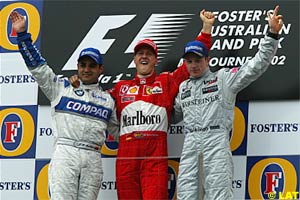 Yet when the red lights went off and the action got started for real on Friday morning, the expectations created during the pre-season, and the rumours about who would be where in Formula One's pecking order, were quickly confirmed in most cases. The end result, with Michael Schumacher getting the best out of his Ferrari F2001 to score his 54th Grand Prix victory in dominant fashion, proved that little has changed at the top of the Formula One field when compared to the previous year.
Yet when the red lights went off and the action got started for real on Friday morning, the expectations created during the pre-season, and the rumours about who would be where in Formula One's pecking order, were quickly confirmed in most cases. The end result, with Michael Schumacher getting the best out of his Ferrari F2001 to score his 54th Grand Prix victory in dominant fashion, proved that little has changed at the top of the Formula One field when compared to the previous year.
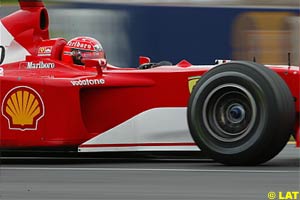 It is still unclear whether Ferrari will use the F2002 in Malaysia, but all the signs indicate that the new car will probably have to wait at least until the Brazilian Grand Prix at the end of March. Of course, the more Ferrari delay the introduction of the new machine, the harder it will be for them to get it up to speed when it finally makes its debut. Only time will tell if they will pay the price for going against the established procedures.
It is still unclear whether Ferrari will use the F2002 in Malaysia, but all the signs indicate that the new car will probably have to wait at least until the Brazilian Grand Prix at the end of March. Of course, the more Ferrari delay the introduction of the new machine, the harder it will be for them to get it up to speed when it finally makes its debut. Only time will tell if they will pay the price for going against the established procedures.
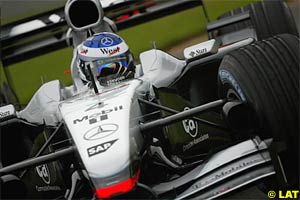 In Melbourne, Michelin seemed to be suffering from the same problem as last year: if the track temperatures are not hot enough, their tyres are no match for the Bridgestones, and while that's the case, both Williams and McLaren will have a tough time beating Ferrari's drivers, no matter what car they are driving.
In Melbourne, Michelin seemed to be suffering from the same problem as last year: if the track temperatures are not hot enough, their tyres are no match for the Bridgestones, and while that's the case, both Williams and McLaren will have a tough time beating Ferrari's drivers, no matter what car they are driving.
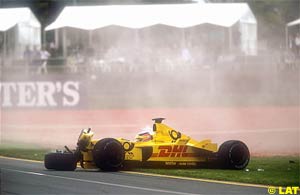 If anyone was expecting the first qualifying of the year to clear the doubts concerning the real pace of the contenders, then Saturday's hour-long session was hardly useful for that purpose. If Williams were sandbagging during the pre-season, if McLaren had made the right choice by switching to Michelin, or if the Ferrari F2001 was still the car to beat, were all questions that remained unanswered once qualifying finished.
If anyone was expecting the first qualifying of the year to clear the doubts concerning the real pace of the contenders, then Saturday's hour-long session was hardly useful for that purpose. If Williams were sandbagging during the pre-season, if McLaren had made the right choice by switching to Michelin, or if the Ferrari F2001 was still the car to beat, were all questions that remained unanswered once qualifying finished.
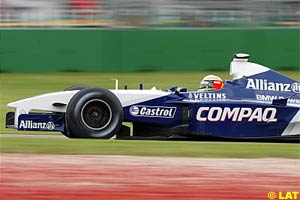 The threatening skies saw the session being run backwards, with most of the cars taking to the track immediately once the pitlane was open. Local hero Mark Webber was the first man on track, with Jordan's rookie Takuma Sato following suit. The Japanese driver, who had crashed heavily during Saturday's practice, could not complete a lap, as his EJ12 suffered a gearbox problem that forced him to park right after Turn 14 and forcing the session to be stopped so the marshals could remove it.
The threatening skies saw the session being run backwards, with most of the cars taking to the track immediately once the pitlane was open. Local hero Mark Webber was the first man on track, with Jordan's rookie Takuma Sato following suit. The Japanese driver, who had crashed heavily during Saturday's practice, could not complete a lap, as his EJ12 suffered a gearbox problem that forced him to park right after Turn 14 and forcing the session to be stopped so the marshals could remove it.
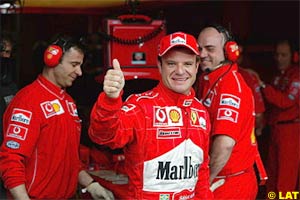 Schumacher's joy was short-lived, as Barrichello immediately knocked him off the top spot by only 0.005 seconds. After that, there were a few moments of calm on the track, something that probably most drivers regretted later on as the rain began to fall just when the session was about to reach its halfway point.
Schumacher's joy was short-lived, as Barrichello immediately knocked him off the top spot by only 0.005 seconds. After that, there were a few moments of calm on the track, something that probably most drivers regretted later on as the rain began to fall just when the session was about to reach its halfway point.
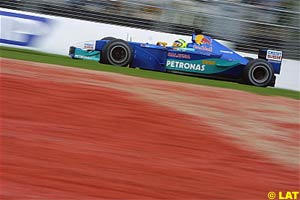 As for the other rookies, Sauber's Felipe Massa got off to a good start by qualifying in a promising ninth place ahead of teammate Nick Heidfeld. The most surprising debutants, however, were Toyota, whose drivers Mika Salo and Allan McNish placed their cars in very respectable 14th and 16th positions, at a track where the Japanese squad have never been to before.
As for the other rookies, Sauber's Felipe Massa got off to a good start by qualifying in a promising ninth place ahead of teammate Nick Heidfeld. The most surprising debutants, however, were Toyota, whose drivers Mika Salo and Allan McNish placed their cars in very respectable 14th and 16th positions, at a track where the Japanese squad have never been to before.
Pos Driver Team Time
1. Barrichello Ferrari (B) 1:25.843 222.392 km/h
2. M.Schumacher Ferrari (B) 1:25.848 + 0.005
3. R.Schumacher Williams BMW (M) 1:26.279 + 0.436
4. Coulthard McLaren Mercedes (M) 1:26.446 + 0.603
5. Raikkonen McLaren Mercedes (M) 1:27.161 + 1.318
6. Montoya Williams BMW (M) 1:27.249 + 1.406
7. Trulli Renault (M) 1:27.710 + 1.867
8. Fisichella Jordan Honda (B) 1:27.869 + 2.026
9. Massa Sauber Petronas (B) 1:27.972 + 2.129
10. Heidfeld Sauber Petronas (B) 1:28.232 + 2.389
11. Button Renault (M) 1:28.361 + 2.518
12. Panis BAR Honda (B) 1:28.381 + 2.538
13. Villeneuve BAR Honda (B) 1:28.657 + 2.814
14. Salo Toyota (M) 1:29.205 + 3.362
15. Frentzen Arrows Cosworth (B) 1:29.474 + 3.631
16. McNish Toyota (M) 1:29.636 + 3.793
17. Bernoldi Arrows Cosworth (B) 1:29.738 + 3.895
18. Webber Minardi Asiatech (M) 1:30.086 + 4.243
19. Irvine Jaguar Cosworth (M) 1:30.113 + 4.270
20. de la Rosa Jaguar Cosworth (M) 1:30.192 + 4.349
21. Yoong Minardi Asiatech (M) 1:31.504 + 5.661
22. Sato Jordan Honda (B) 1:53.351 + 27.508 *
Outside the 107%
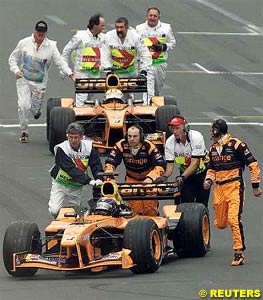 Heavy rain during the morning warm-up did not change much at the top, and the Ferrari duo were still on top - just like in every session during the weekend, with Michael Schumacher more than two seconds ahead of the third quickest car.
Heavy rain during the morning warm-up did not change much at the top, and the Ferrari duo were still on top - just like in every session during the weekend, with Michael Schumacher more than two seconds ahead of the third quickest car.
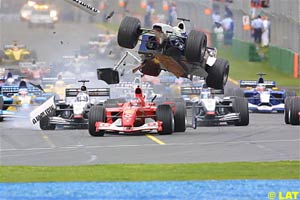 "I tried to go on the inside and he closed the door, then I tried to go on the outside and he closed the door again," Schumacher said. "I tried to go back on the inside, he closed the door and braked at the same time, then he tried to brake into the first corner. It was a great start and it's a shame I did not make use of it."
"I tried to go on the inside and he closed the door, then I tried to go on the outside and he closed the door again," Schumacher said. "I tried to go back on the inside, he closed the door and braked at the same time, then he tried to brake into the first corner. It was a great start and it's a shame I did not make use of it."
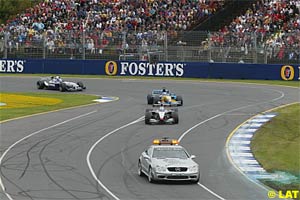 "I think it is ridiculous that the race wasn't stopped as most of the drivers were left to watch the race on TV," added Fisichella, while Coulthard, on the other hand, defended the FIA's decision: "I've always felt that to deprive the spectators of a number of cars in a first corner incident is not good for the business, but this isn't Hollywood, it's real, and you don't cut out the bits you don't like. As long as it's always consistent and a driver is not hurt or trapped in a car, they will send out the safety car."
"I think it is ridiculous that the race wasn't stopped as most of the drivers were left to watch the race on TV," added Fisichella, while Coulthard, on the other hand, defended the FIA's decision: "I've always felt that to deprive the spectators of a number of cars in a first corner incident is not good for the business, but this isn't Hollywood, it's real, and you don't cut out the bits you don't like. As long as it's always consistent and a driver is not hurt or trapped in a car, they will send out the safety car."
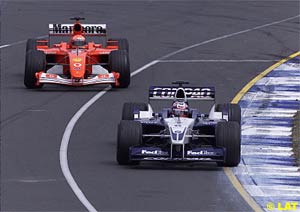 Up in front, Montoya got right behind Schumacher and in a brave move, he passed the German around the outside. By that time, Raikkonen was already in third place, with Coulthard down in fourth followed by Irvine and de la Rosa. Schumacher followed Montoya closely for a few laps, obviously being able to lap faster than the Williams driver, whose Michelin tyres were no match for the German's Bridgestone.
Up in front, Montoya got right behind Schumacher and in a brave move, he passed the German around the outside. By that time, Raikkonen was already in third place, with Coulthard down in fourth followed by Irvine and de la Rosa. Schumacher followed Montoya closely for a few laps, obviously being able to lap faster than the Williams driver, whose Michelin tyres were no match for the German's Bridgestone.
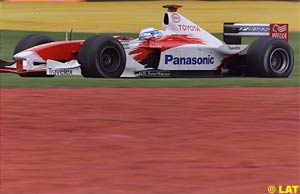 Webber was one of the first men to come into the pits for his first and only scheduled stop on lap 34. Things, however, did not go according to plan and the Australian's car stood still for more than 30 seconds before he could rejoin the race, still in fifth place.
Webber was one of the first men to come into the pits for his first and only scheduled stop on lap 34. Things, however, did not go according to plan and the Australian's car stood still for more than 30 seconds before he could rejoin the race, still in fifth place.
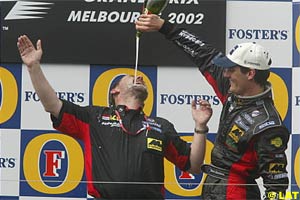 A somewhat disappointed Montoya was second, while Raikkonen visited the podium for the first time, after a solid performance in his first race for McLaren. Irvine and Jaguar were fourth - a result they could only have dreamt of following their poor showing during qualifying. The happiest men, however, were in the Minardi pits, after rookie Webber had given them their first Championship points since 1999.
A somewhat disappointed Montoya was second, while Raikkonen visited the podium for the first time, after a solid performance in his first race for McLaren. Irvine and Jaguar were fourth - a result they could only have dreamt of following their poor showing during qualifying. The happiest men, however, were in the Minardi pits, after rookie Webber had given them their first Championship points since 1999.
CLASSIFIED
Pos Driver Team Time
1. M.Schumacher Ferrari (B) 1h35:36.792
2. Montoya Williams BMW (M) + 0:18.628
3. Raikkonen McLaren Mercedes (M) + 0:25.067
4. Irvine Jaguar Cosworth (M) + 1 Lap
5. Webber Minardi Asiatech (M) + 2 Laps
6. Salo Toyota (M) + 2 Laps
7. Yoong Minardi Asiatech (M) + 3 Laps
8. de la Rosa Jaguar Cosworth (M) + 5 Laps
Fastest Lap: K.Raikkonen, 1:28.541, lap 37
NOT CLASSIFIED / RETIREMENTS
Coulthard McLaren Mercedes (M) 34
Villeneuve BAR Honda (B) 28
Sato Jordan Honda (B) 13
Trulli Renault (M) 9
Barrichello Ferrari (B) 1
R.Schumacher Williams BMW (M) 1
Fisichella Jordan Honda (B) 1
Massa Sauber Petronas (B) 1
Heidfeld Sauber Petronas (B) 1
Button Renault (M) 1
Panis BAR Honda (B) 1
McNish Toyota (M) 1
Frentzen Arrows Cosworth (B) DQ
Bernoldi Arrows Cosworth (B) DQ
WORLD CHAMPIONSHIP STANDING, ROUND 1:
Drivers: Constructors:
1. M.Schumacher 10 1. Ferrari 10
2. Montoya 6 2. Williams-BMW 6
3. Raikkonen 4 3. McLaren-Mercedes 4
4. Irvine 3 4. Jaguar-Cosworth 3
5. Webber 2 5. Minardi-Asiatech 2
6. Salo 1 6. Toyota 1
Pos Driver Team Lap Time
1. Raikkonen McLaren Mercedes (M) 37 1:28.541
2. M.Schumacher Ferrari (B) 32 1:28.628 + 0.087
3. Montoya Williams BMW (M) 35 1:29.143 + 0.602
4. Coulthard McLaren Mercedes (M) 21 1:31.186 + 2.645
5. de la Rosa Jaguar Cosworth (M) 51 1:31.539 + 2.998
6. Salo Toyota (M) 53 1:32.225 + 3.684
7. Irvine Jaguar Cosworth (M) 36 1:32.548 + 4.007
8. Webber Minardi Asiatech (M) 52 1:33.296 + 4.755
9. Villeneuve BAR Honda (B) 25 1:33.540 + 4.999
10. Trulli Renault (M) 7 1:34.233 + 5.692
11. Yoong Minardi Asiatech (M) 36 1:34.653 + 6.112
12. Sato Jordan Honda (B) 8 1:35.197 + 6.656
Pos Driver Team Time Lap
1. Villeneuve BAR Honda (B) 26.883 10
2. Villeneuve BAR Honda (B) 27.257 13
3. de la Rosa Jaguar Cosworth (M) 27.246 40
4. Montoya Williams BMW (M) 27.999 37
5. M.Schumacher Ferrari (B) 28.281 38
6. Raikkonen McLaren Mercedes (M) 28.290 38
7. Salo Toyota (M) 30.069 32
8. Irvine Jaguar Cosworth (M) 31.632 37
9. Yoong Minardi Asiatech (M) 32.838 37
10. Webber Minardi Asiatech (M) 54.025 35
11. Sato Jordan Honda (B) 1:09.258 11
12. Raikkonen McLaren Mercedes (M) 1:10.122 2
13. Salo Toyota (M) 3:14.314 1
14. de la Rosa Jaguar Cosworth (M) 4:30.135 21
The Australian Grand Prix, Lap by Lap
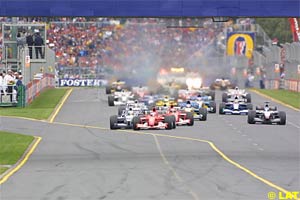 Before the start of the race there are major problems for the Arrows team with both Enrique Bernoldi and Heinz-Harald Frentzen being left standing on the grid as the field departs for the final parade lap. The cars cannot be started and eventually they are pushed into the pitlane exit.
Before the start of the race there are major problems for the Arrows team with both Enrique Bernoldi and Heinz-Harald Frentzen being left standing on the grid as the field departs for the final parade lap. The cars cannot be started and eventually they are pushed into the pitlane exit.
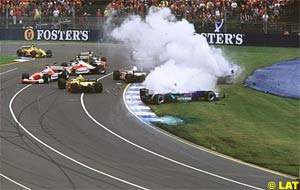 Lap 6: The race restarts with Coulthard setting off in the lead while Montoya challenges Trulli for second and goes wide, allowing Schumacher to pass the Williams and chase after Trulli. Further back Raikkonen begins his charge back up the order from eleventh to ninth.
Lap 6: The race restarts with Coulthard setting off in the lead while Montoya challenges Trulli for second and goes wide, allowing Schumacher to pass the Williams and chase after Trulli. Further back Raikkonen begins his charge back up the order from eleventh to ninth.
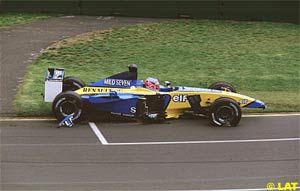 Lap 12: The race is on again and Montoya blasts ahead of Schumacher as the two men go down into the first corner. Raikkonen is up to third with Coulthard fourth, Irvine fifth and de la Rosa back to sixth because Sato goes into the pits.
Lap 12: The race is on again and Montoya blasts ahead of Schumacher as the two men go down into the first corner. Raikkonen is up to third with Coulthard fourth, Irvine fifth and de la Rosa back to sixth because Sato goes into the pits.
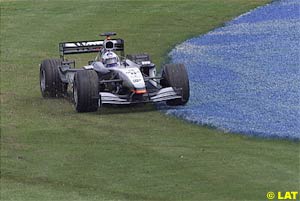 Lap 22: Schumacher's lead is already up to 11 seconds, Coulthard continues to have problems and goes off again.
Lap 22: Schumacher's lead is already up to 11 seconds, Coulthard continues to have problems and goes off again.
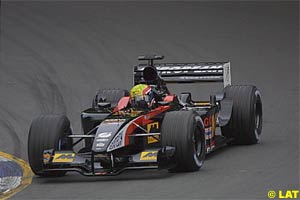 Lap 35: Webber stops and there is a problem with the fuel flap and he loses 34 seconds as the problem is solved.
Lap 35: Webber stops and there is a problem with the fuel flap and he loses 34 seconds as the problem is solved.
Please Contact Us for permission to republish this or any other material from Atlas F1.